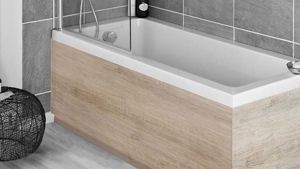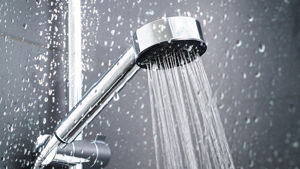We all know we need to save water in our homes. Water is a vital resource but millions of litres is wasted in the UK every year. That's where you come in. With just a few tweaks, you can cut your water usage drastically and ensure there's enough for future generations.
UK Water Facts
Before we look at how you can save water, take a look at these facts about UK water consumption and wastage:
- The demand for water in the UK is growing at roughly 1% per year.
- The average person in the UK uses 150 litres of water per day.
- The UK has less water per person available for use than most other European countries.
- 58 bathtubs of water are used per person everyday to make the products we buy and food we eat.
With all this in mind, it's easy to see why it's so crucial for us all to start saving water!
Saving Water In Your Bathroom
Shower
One of the easiest ways you can save water at home is switching some of your baths to showers. At typical bath will use around 100 litres of water, which is almost 3 times as much as a shower. If you do want to keep having a bath, try filling it up a little less or add some more bubble bath so the water feels deeper than it is. If you find yourself topping up the water in a bath every so often because it’s going cold, you could always purchase a reinforced acrylic or steel bath. Both of these types retain heat for anything up to 30 minutes longer than a conventional bath, eliminating any need for a top up.
Despite the savings versus a bath, a shower can still use around 35 litres of water, or up to 125 litres if you are using a power shower. Purchasing a water saving shower head will help you use less water with little noticeable difference to performance. Many showers will also have adjustable flow rate settings. If you can, try to avoid running your shower at the highest power level every time you shower.
Shortening the time of your showers can also help. By reducing the time spent in the shower by 4 minutes each day, you can save up to 3000 gallons of water per year!
Water Saving At The Toilet
About a third of all water usage in households comes from the toilet, so this is the perfect place to start saving water. One of the biggest culprits of toilet water usage is old cisterns with high flush capacity. These older toilets will use a lot more water than is necessary, which means gallons of water every day can be wasted. If you are looking for a cheaper option than replacing your toilet to reduce this wastage, add a displacement device to your cistern. This will reduce the amount of water in the cistern and therefore the amount that comes through in the flush.
Although water displacement can help, upgrading to a toilet with a dual flush plate will lead to much greater water savings. These allow you to choose either a full flush, or a reduced flush depending on what's required. This is an easy way to cut your water consumption and requires very little change in your daily habits.
Check Your Toilet For Leaks
Sometimes old toilets can be leaking water without you even knowing it. One easy way to check this is adding some food colouring into the tank. If you see coloured water running down the pan when you haven't flushed, chances are you have a crack or a leak.
At The Basin
One of the easiest ways to save water daily is turning the tap off whilst you brush your teeth. Leaving the tap running as you brush can waste up to 10 litres a minute and research has shown that if everyone in the UK turned their taps off while they brushed, 960 billion litres of water could be saved every year!

Another easy way to save water is reducing the flow of your tap. When you are washing your hands or rinsing your toothbrush do you really need to run the tap on its highest setting? Reducing the flow rate will help you conserve water.
Saving Water In The Kitchen
10% of water usage in the home comes from the kitchen, so this is an important part of saving water at home.
Dishwashers
Despite popular belief, dishwashers will often use less water than washing dishes by hand. However, this efficiency is only achieved when running the dishwasher full so make sure when you do use it, it's at full capacity.

Soak Stubborn Pots & Pans
If you have pots and pans that you're struggling to get clean, leave them to soak. The water used to soak the grease off a pan will usually be less than the amount of water you'll use running the tap and scrubbing.
Capture Running Water
Most people will need to run their tap for a few moments to achieve the desired temperature. Whilst you wait for the water to cool down or warm up don't let this water go to waste, capture it in a jug for other uses around the home such as watering plants or mopping floors.
Wash Food In Larger Quantities
When washing fruits and vegetables over your sink, try and wash them in large batches to save water. For example, if you are washing lettuce for a salad, rather than just rinsing what you need at that moment, rinse the whole lettuce and store the rest for when you need it later. This will cut your water consumption as you'll need to leave the tap running for less time.

Use The Correct Sized Pans
When cooking food, using the right size pan is vital to reduce water wastage. Using pans which are too large for the amount of food can lead to litres of water and energy wastage.
Install an Aerated Tap
Aerators are small devices which separate the water flow from the tap into many tiny streams. The streams are then mixed with air as they leave the tap so less water is needed to provide the same feel and performance as a regular tap.
Check For Leaks
Leaking pipes will waste water before you've even had a chance to use it, so it's a good idea to periodically check the pipes around your kitchen taps for any signs of leakage. This is not only good for the environment but it will also reduce the chances of damage that leaking pipes can cause.
Fix Dripping Taps
Similar to leaks, a dripping tap is washing water (and money) straight down the drain. It's been estimated that a dripping tap could waste up to 15 litres of water a day! Don't believe us? Place a water container under a dripping tap in your home and we're sure you'll be shocked at how much accumulates over the day. If you can't fix your dripping tap, it could be time to replace it.

Utilise Double Bowl Sinks
A double bowl sink can be really effective in the drive to save water. Instead of leaving the water running while you clean dishes, fill one bowl of your kitchen sink with soapy water for washing and one with clear water for rinsing the dishes. This will drastically reduce the amount of water you need to wash up.








